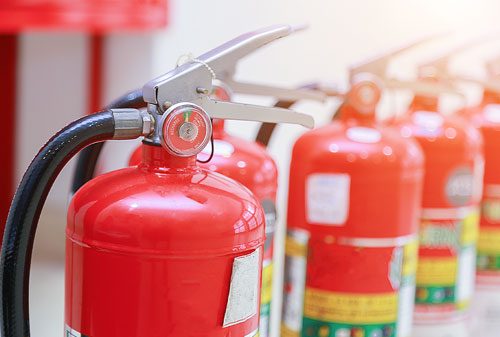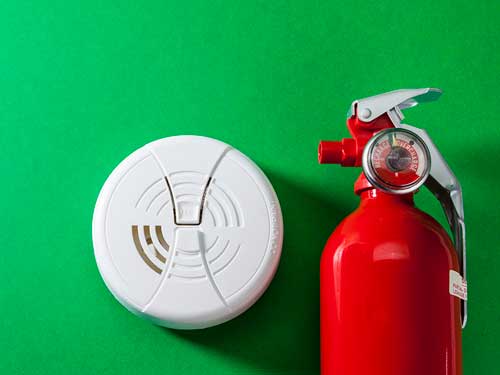




The legislation and the regulations below state the general duties that need to be implemented in order to ensure fire safety.
This act came into force in order to protect workers and employers in work settings. As part of this act, there are safety policies relating to safety procedures in case of fire, accidents or any other emergency. It places specific duties on workers to ensure that they follow the appropriate procedures. It promotes the use of equipment which is available to use in an emergency. The act emphasises that workers' procedures should not place others in danger. It places a number of duties on employers to ensure that they take the necessary steps to promote the health and safety of workers. They are responsible for arranging regular training and for ensuring that everybody feels confident undertaking risk assessments. A number of regulations are based on this act.
When a workplace is registered, it will be inspected by fire officers who will give advice with regard to keeping the workplace safe. The workplace will have to show how it evacuates the building and these procedures should be practised regularly. Regular drills should be held at different times of the day so that everybody is familiar with the arrangements. Signs should be placed in the room showing the steps to be taken in case of fire. Every fire exit should be kept clear. Fire extinguishers should be checked regularly and placed in appropriate locations. Fire blankets should also be available in the kitchen.
It was introduced in October 2006, emphasising that every building must meet the required standards. These standards can be found on the government website:
Individuals are responsible for undertaking risk assessments in order to identify, manage and minimise the fire risk at the setting. Ever worker should be trained in fire safety, including general awareness, fire safety duties, how to undertake a risk assessment and how to use fire extinguishers.
It contains guidelines on how to meet the Regulatory Reform (Fire Safety) Order 2005. It is essential that a member of the setting's management team takes the relevant steps to minimise the risk of harm, ensuring that people are able to escape in a fire emergency. Local fire and rescue authorities are responsible for ensuring that the workplace complies with the legislation. They place responsibility for fire safety on the employer as the appropriate person.
Mae’r deddfwriaethau a’r rheoliadau isod yn nodi dyletswyddau cyffredinol sydd angen eu rhoi ar waith er mwyn sicrhau diogelwch tân.
Daeth y ddeddf hon i rym er mwyn amddiffyn gweithwyr a chyflogwyr o fewn lleoliadau gwaith. Fel rhan o’r ddeddf mae yna bolisïau diogelwch a fydd yn ymdrin â gweithdrefnau diogelwch mewn achosion tân, damweiniau neu unrhyw argyfwng arall. Mae’n gosod dyletswyddau penodol ar weithwyr fel eu bod yn dilyn y gweithdrefnau priodol. Mae’n hyrwyddo defnydd o offer sydd ar gael i’w defnyddio mewn argyfwng. Mae’r ddeddf yn pwysleisio na ddylai gweithdrefnau gweithwyr roi eraill mewn perygl. Mae’n rhoi llawer o ddyletswyddau i’r cyflogwyr gan sicrhau eu bod yn cymryd camau angenrheidiol i hyrwyddo iechyd a diogelwch y gweithwyr. Mae ganddynt rôl i drefnu hyfforddiant rheolaidd a sicrhau bod pawb yn hyderus i wneud asesiadau risg. Mae llawer o reoliadau’n deillio o’r ddeddf hon.
Pan fydd gweithle yn cael ei gofrestru, bydd yn cael ei harolygu gan swyddogion tân a fydd yn rhoi cyngor ar sut i gynnal gweithle diogel. Bydd rhaid i’r gweithle ddangos sut mae’n gwagio’r adeilad a dylai’r gweithdrefnau hyn gael eu hymarfer yn rheolaidd. Dylid cynnal ymarferion yn gyson ar wahanol adegau o’r dydd fel bod pawb yn cyfarwyddo â’r drefn. Dylai arwyddion gael eu gosod yn yr ystafell sy’n nodi’r camau y dylid cymryd os bydd tân. Dylai pob allanfa dân gael eu cadw’n glir. Dylid gwirio diffoddwyr tân yn rheolaidd a’u gosod mewn mannau priodol. Dylid hefyd sicrhau bod blancedi tân ar gael yn y gegin.
Cafodd ei gyflwyno ym mis Hydref 2006 gan bwysleisio bod yn rhaid i bob adeilad gwrdd â’r safonau gofynnol. Gellir dod o hyd i’r safonau yma ar wefan y llywodraeth:
Mae cyfrifoldeb gan unigolion i gynnal asesiadau risg er mwyn adnabod, rheoli a lleihau'r risg o dân o fewn y lleoliad. Dylai pob gweithiwr dderbyn hyfforddiant ar ddiogelwch tân a fydd yn cynnwys ymwybyddiaeth gyffredinol, dyletswyddau diogelwch tân, sut mae gwneud asesiadau risg a sut i ddefnyddio diffoddwyr tân.
Mae’n cynnig canllawiau ar sut i gwrdd â Gorchymyn diwygio rheoleiddio (diogelwch tân) 2005. Mae’n hanfodol bod pob aelod o dîm rheoli’r lleoliad yn cymryd camau perthnasol i leihau’r risg o niwed gan sicrhau y gall pobl ddianc mewn argyfwng tân. Awdurdodau lleol tân ac achub sy’n gyfrifol am sicrhau bod y gweithle’n cydymffurfio â’r ddeddfwriaeth. Maent yn rhoi cyfrifoldeb ar y cyflogwr fel y person priodol i fod yn gyfrifol am ddiogelwch tân.
Complete the activity below.
Cwblhewch y gweithgaredd isod.

Legislation and Regulations are in force to ensure practice that protects staff, children/young people and their families/carers in a fire emergency. The laws underline what employers and workers are required to do.
| Employers | Workers |
|---|---|
| promote the health and safety of workers | follow procedures |
| arrange training for the workers | correct use of equipment |
| plan and implement appropriate fire safety measures | avoid endangering colleagues |
| ensure that everybody is confident in undertaking risk assessments | show how to evacuate the building |
| check fire extinguishers on a regular basis | carry out regular drills at different times during the day |
| ensure that there are fire blankets available in the kitchen | keep records of fire drills |
| ensure that there are plans showing the location of fire exits | responsibility for children and young people in their care |
| appoint a person to be responsible for fire safety at the setting | place signs in the room showing the steps to be taken in case of fire |
| manage fire-related risks | keep all fire exits clear |
| responsibility for the health and safety of every individual on the site | undertake regular risk assessments |
| attend regular training | monitor and review risk assessments |
| inspect fire safety on the site | attend regular training |
In most settings, the local fire and rescue authorities are responsible for ensuring that the workplace complies with fire safety legislation.
Mae Deddfwriaeth a Rheoliadau yn eu lle er mwyn gweithredu arfer sy’n amddiffyn staff, plant/pobl ifanc a’u teuluoedd/gofalwyr mewn argyfwng tân. Mae’r cyfreithiau’n tanlinellu’r hyn sy’n ofynnol i’r cyflogwyr a’r gweithwyr eu gwneud.
| Cyflogwyr | Gweithwyr |
|---|---|
| hyrwyddo iechyd a diogelwch gweithwyr | dilyn gweithdrefnau |
| trefnu hyfforddiant i weithwyr | defnydd cywir o offer |
| cynllunio a chynnal mesuriadau diogelwch tân priodol | peidio â pheryglu cydweithwyr |
| sicrhau bod pawb yn hyderus i gynnal asesiadau risg | dangos sut mae gwagio’r adeilad |
| gwirio diffoddwyr tân yn rheolaidd | cynnal ymarferion cyson ar wahanol adegau o’r dydd |
| sicrhau bod blanced tân ar gael yn y gegin | cadw cofnodion o ymarferion tân |
| sicrhau bod cynlluniau ar gael sy’n dangos safleoedd allanfeydd tân | cyfrifoldeb dros blant a phobl ifanc yn eu gofal |
| penodi person i fod yn gyfrifol am ddiogelwch tân yn y lleoliad | gosod arwyddion yn yr ystafell sy’n nodi’r camau y dylid cymryd os bydd tan |
| rheoli risgiau yn ymwneud â thân | cadw pob allanfa dân yn glir |
| cyfrifoldeb dros iechyd a diogelwch pawb ar y safle | cynnal asesiadau risg cyson |
| mynychu hyfforddiant cyson | monitro ac adolygu asesiadau risg |
| arolygu diogelwch tân y safle | mynychu hyfforddiant cyson |
Yn y mwyafrif o leoliadau, yr awdurdodau lleol tân ac achub sy’n gyfrifol am sicrhau bod y gweithle’n cydymffurfio â deddfwriaeth diogelwch tân.
Hint 3: Lorem ipsum dolor sit amet, consectetur adipisicing elit. Modi est praesentium earum exercitationem, accusantium molestiae asperiores reiciendis aliquam doloribus, delectus, cumque odio omnis rem, aliquid et. Quisquam eius, incidunt ab.
Awgrymiadau 3: Lorem ipsum dolor sit amet, consectetur adipisicing elit. Modi est praesentium earum exercitationem, accusantium molestiae asperiores reiciendis aliquam doloribus, delectus, cumque odio omnis rem, aliquid et. Quisquam eius, incidunt ab.
Drag the responsibilities to the correct column.
Llusgwch y cyfrifoldebau i’r golofn gywir.
Hint 4: Lorem ipsum dolor sit amet, consectetur adipisicing elit. Modi est praesentium earum exercitationem, accusantium molestiae asperiores reiciendis aliquam doloribus, delectus, cumque odio omnis rem, aliquid et. Quisquam eius, incidunt ab.
Awgrymiadau 4: Lorem ipsum dolor sit amet, consectetur adipisicing elit. Modi est praesentium earum exercitationem, accusantium molestiae asperiores reiciendis aliquam doloribus, delectus, cumque odio omnis rem, aliquid et. Quisquam eius, incidunt ab.

Early years and childcare workers need to take steps to prevent fires from starting and spreading. Developing understanding is vitally important. The more information that practitioners have, the more likely they will be to be able to deal with a situation without panicking. Fire is a chemical reaction, where heat and light are produced. Heat, fuel and oxygen are required, in the correct proportions, to light a fire. Understanding this is good practice with regard to preventing fires.
The following can ensure good practice with regard to preventing fires from starting and spreading:
http://bit.ly/2YA7EHJ (includes activities)
Mae gweithiwr gofal plant a gofal plant angen cymryd camau er mwyn atal tanau rhag dechrau a lledaenu. Mae datblygu dealltwriaeth yn allweddol bwysig. Y mwyaf o wybodaeth sydd gan gweithwyr gofal plant, y mwyaf tebygol y byddan nhw’n medru ymdrin â sefyllfa heb fynd i banig. Adwaith cemegol yw tân, pan mae gwres a golau yn cael eu cynhyrchu. Rhaid cael gwres, tanwydd ac ocsigen er mwyn cynnau tan, a hynny yn y cyfrannau cywir. Mae deall hyn yn arfer da o ran atal tanau.
Gall wneud yr isod sicrhau arfer da o ran atal tanau rhag dechrau a lledaenu:
http://bit.ly/2LQK0Rl (yn cynnwys gweithgareddau)
Hint 5: Lorem ipsum dolor sit amet, consectetur adipisicing elit. Modi est praesentium earum exercitationem, accusantium molestiae asperiores reiciendis aliquam doloribus, delectus, cumque odio omnis rem, aliquid et. Quisquam eius, incidunt ab.
Awgrymiadau 5: Lorem ipsum dolor sit amet, consectetur adipisicing elit. Modi est praesentium earum exercitationem, accusantium molestiae asperiores reiciendis aliquam doloribus, delectus, cumque odio omnis rem, aliquid et. Quisquam eius, incidunt ab.
Taking the steps below can ensure good practice with regard to preventing fires from starting and spreading.
Look at the picture and note the answer.
Gall gwneud yr isod sicrhau arfer da er mwyn atal tanau rhag dechrau a lledaenu.
Edrychwch ar y llun a nodwch yr ateb.
Hint 6: Lorem ipsum dolor sit amet, consectetur adipisicing elit. Modi est praesentium earum exercitationem, accusantium molestiae asperiores reiciendis aliquam doloribus, delectus, cumque odio omnis rem, aliquid et. Quisquam eius, incidunt ab.
Awgrymiadau 6: Lorem ipsum dolor sit amet, consectetur adipisicing elit. Modi est praesentium earum exercitationem, accusantium molestiae asperiores reiciendis aliquam doloribus, delectus, cumque odio omnis rem, aliquid et. Quisquam eius, incidunt ab.

It is important to be aware of the setting's policy and the procedure to follow in case of an emergency. If there is a fire on the site, it is important to have guidelines in place to be able to keep each child and adult safe. The procedure to be followed in an emergency must be practised regularly and recorded. The date and any problem arising must be recorded, as well as the time taken to evacuate the building. This will enable people to deal with the situation calmly.
It is a good idea to use different exits during drills so that everybody can familiarise themselves with evacuating the setting quickly and safely. Information must be available on how to use the fire extinguishers and such equipment and the fire alarm must be tested regularly. If the emergency is related to water, electricity or gas, information must be available on how to disconnect the supply. The location of torches and lamps should also be known in case of a power cut. The parents/carers should also be aware of the procedure in case they are in the building during a fire emergency.
Fire drills can be mentioned in advanced to the children by discussing the procedures to follow. Relevant stories can also be shared, e.g. 'Fireman Sam'. This will prevent the child from worrying about the fire drills and knowing what to do during the drills. The children may want to discuss their concerns and fears with regard to the fire drills with their parents/carers. Parents/carers can encourage their children to discuss their concerns and can reinforce the procedures for the fire drill.
Children need to be aware of the difficulties associated with evacuating a smoke-filled site. They need to learn that they will need to get down to a lower level and crawl across the floor. Fire drills can be held where the children close their eyes and feel their way around the setting or the home. Regardless of the situation, the children must be praised and thanked for taking part in the evacuation drill.
The following procedures should be followed in case of a fire emergency:
It is essential to keep exits clear at all times. Failure to do so may lead to serious consequences for all within the setting; consequences which could have been avoided.
Mae’n bwysig bod yn ymwybodol o bolisi’r lleoliad a’r drefn i’w ddilyn mewn achos o argyfwng. Os oes tân ar y safle mae’n bwysig fod canllawiau mewn lle er mwyn medru cadw pob plentyn ac oedolyn yn ddiogel. Rhaid ymarfer y drefn i’w chymryd mewn argyfwng yn rheolaidd a’i chofnodi. Rhaid cofnodi’r dyddiad ac unrhyw broblem a gododd, yn ogystal â’r amser a gymerwyd i wagio’r adeilad. Bydd hyn yn caniatáu i bobl ddelio â’r sefyllfa mewn ffordd dawel.
Mae’n syniad i ddefnyddio allanfeydd gwahanol yn ystod ymarferion fel bod pawb yn ymgyfarwyddo â gwagio’r lleoliad yn gyflym ac yn ddiogel. Rhaid gwybod sut mae defnyddio offer diffodd tân gan brofi’r offer hwn a’r larwm tân yn rheolaidd. Os yw’r argyfwng yn ymwneud â dŵr, trydan neu nwy, rhaid gwybod sut i ddiffodd y cyflenwad. Dylid hefyd wybod ble mae tortshys a’r lampau yn cael eu cadw rhag ofn bydd toriad trydan. Dylai’r rhieni/gofalwyr hefyd wybod y drefn rhag ofn eu bod yn yr adeilad pan fydd argyfwng tân.
Gellir sôn am ymarferion tân ymlaen llaw gyda’r plant drwy drafod yr arferion i’w dilyn. Gellir hefyd rannu storïau sy’n ymwneud â sefyllfa o’r fath, e.e. ‘Sam Tân’. Bydd hyn yn atal y plentyn i ofidio am yr ymarferion tân a gwybod beth i’w wneud yn ystod yr ymarferion. Efallai bydd y plant eisiau trafod eu pryderon a’u hofnau am ymarferion tân gyda’u rhieni/gofalwyr. Gall rhieni/gofalwyr annog eu plant i siarad am eu pryderon gan gynnig atgyfnerthiad o drefn yr ymarfer.
Mae angen i blant fod yn ymwybodol o anawsterau gwagio safle pan fydd mwg ynddo. Mae angen iddynt ddysgu bod angen mynd lawr yn isel a chropian ar y llawr. Gellir cynnal ymarferion lle mae plant yn cau eu llygaid a theimlo’u ffordd o amgylch y lleoliad neu’r cartref. Beth bynnag fo’r sefyllfa, mae’n rhaid canmol y plant a diolch iddynt am gymryd rhan yn yr ymarfer ymgilio.
Dylid dilyn yr arfer canlynol mewn argyfwng tân:
Mae’n hanfodol cadw allanfeydd yn glir bob amser. Gall methu a gwneud hyn gael canlyniadau difrifol ar bawb o fewn y lleoliad; canlyniadau a ellir cael eu hosgoi.
Hint 7: Lorem ipsum dolor sit amet, consectetur adipisicing elit. Modi est praesentium earum exercitationem, accusantium molestiae asperiores reiciendis aliquam doloribus, delectus, cumque odio omnis rem, aliquid et. Quisquam eius, incidunt ab.
Awgrymiadau 7: Lorem ipsum dolor sit amet, consectetur adipisicing elit. Modi est praesentium earum exercitationem, accusantium molestiae asperiores reiciendis aliquam doloribus, delectus, cumque odio omnis rem, aliquid et. Quisquam eius, incidunt ab.
Drag the word into the correct space in order to complete the sentences.
Llusgwch y gair i’r bwlch cywir er mwyn cwblhau’r brawddegau.
You scored … out of . Move some of the terms around to try to improve your score.
Well done. You scored … out of .
You scored … out of . Click reset to try the activity again.
You scored … out of . Move some of the terms around to try to improve your score.
Well done. You scored … out of .
You scored … out of . Click reset to try the activity again.
Eich sgôr yw … allan o . Symudwch rhai o'r termau o gwmpas i geisio gwella eich sgôr.
Da iawn. Eich sgôr yw … allan o .
Eich sgôr yw … allan o . Cliciwch ‘ailosod’ er mwyn rhoi cynnig arall ar y gweithgaredd.
Eich sgôr yw … allan o . Symudwch rhai o'r termau o gwmpas i geisio gwella eich sgôr
Da iawn. Eich sgôr yw … allan o .
Eich sgôr yw … allan o . Cliciwch ‘ailosod’ er mwyn rhoi cynnig arall ar y gweithgaredd.
Hint 8: Lorem ipsum dolor sit amet, consectetur adipisicing elit. Modi est praesentium earum exercitationem, accusantium molestiae asperiores reiciendis aliquam doloribus, delectus, cumque odio omnis rem, aliquid et. Quisquam eius, incidunt ab.
Awgrymiadau 8: Lorem ipsum dolor sit amet, consectetur adipisicing elit. Modi est praesentium earum exercitationem, accusantium molestiae asperiores reiciendis aliquam doloribus, delectus, cumque odio omnis rem, aliquid et. Quisquam eius, incidunt ab.